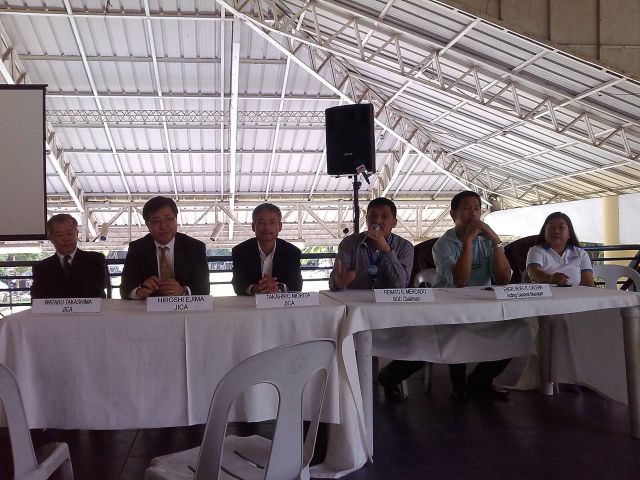
JICA officials Wataru Takashima, Hiroshi Ejima, and Takahiro Morita together with MCWD officials led by Renato Mercado, Noel Dalena, and Helen Aragones discuss the benefits of the new equipment. (CDN PHOTO/MARY CLAIRE U. CATADO)
The Japan International Cooperation Agency (JICA) turned over P33 million worth of equipment to the Metropolitan Cebu Water District (MCWD) yesterday.
Renato Mercado, MCWD board of directors chairman, said that the two mobile siphon filtration tanks (MSTs) and one sand washer will benefit their 2.5 million consumers.
MSTs are truck-mounted equipment that can produce 7 to 20 cubic meters of potable water per hour.
The sand washer, on the other hand, is used to remove turbidity and to disinfect raw water.
JICA used MSTs to provide potable water to Daanbantayan residents after Supertyphoon Yolanda devastated the town.
Mercado also said that he will recommend the use of these equipment beyond the boundaries of Metro Cebu.
“I will strongly recommend this to Mega Cebu which has 15 participating local government units to deliver the mandate of sanitation,” he said.
Mercado said JICA and MCWD planned to conduct a water academy to teach others what they have learned.
“We will be organizing a water academy to echo what we’ve learned not only in Cebu but to the other 600 water districts in the Philippines. This will also help improve the competence of our technicians,” he said.
Osamu Kanda, assistant manager for overseas management division of Nihon Genryo, said that 95 percent of water sources in Cebu are from ground water sources.
In terms of water quality, he said that people in Cebu are facing a high concentration of manganese and iron.
“We have provided rehabilitation and treatment to the ground water. We have also provided technical assistance and training to MCWD,” Kanda said.
He also said that the pilot survey for Disseminating Technologies for Mobile Sand Filtration Tank for Drinking Water and Rehabilitation System for Sand Filter will be done within the month.
“We are now using applied technology to overcome the problems with our water supply and quality,” he said.
MCWD Laboratory head Helen Aragones said that the common concentration of manganese in Cebu’s water supply is between 1.0 and 1.5 parts per million (ppm). However, after the use of MSTs, the level goes down to a range of 0.3-0.1 ppm.
Aragones said that although manganese can help the body, great amounts would not be beneficial to one’s health.
“The permissible level of manganese is 0.5 ppm as set by the Department of Health and the Philippine standards for drinking water,” she said.
Takahiro Morita of JICA said that the partnership between JICA and MCWD will still continue even after the termination of the project.
“We hope that MCWD will take the lead to disseminate the knowledge of these technologies to other provinces,” Morita said.